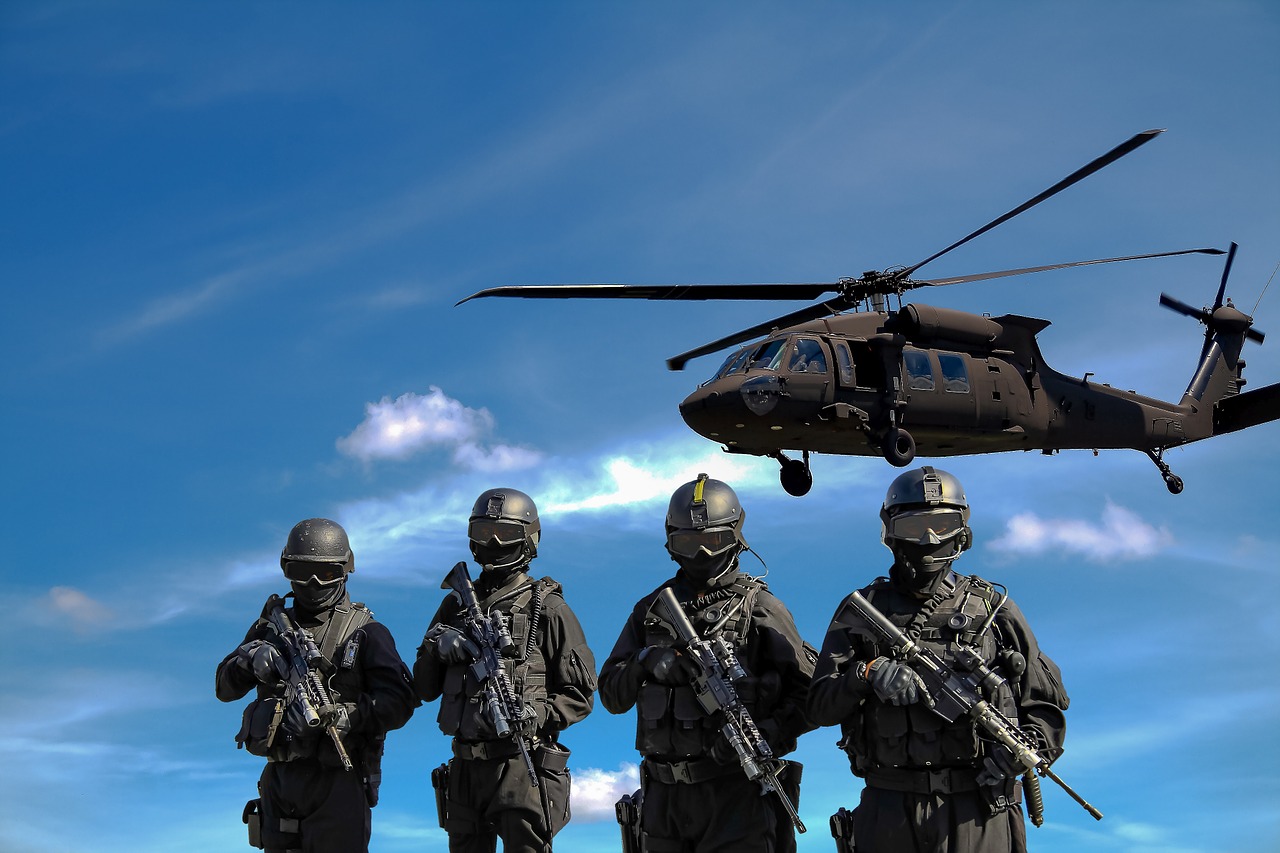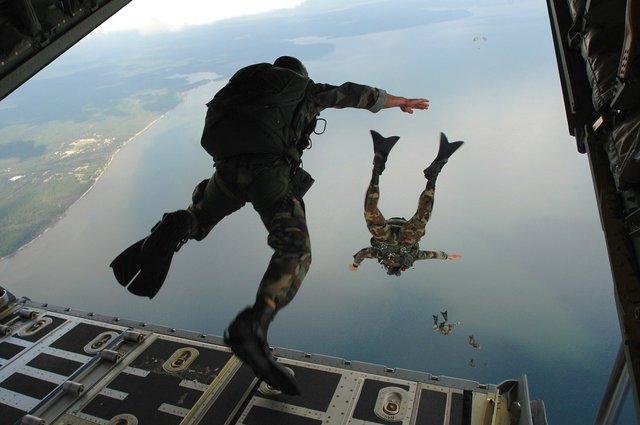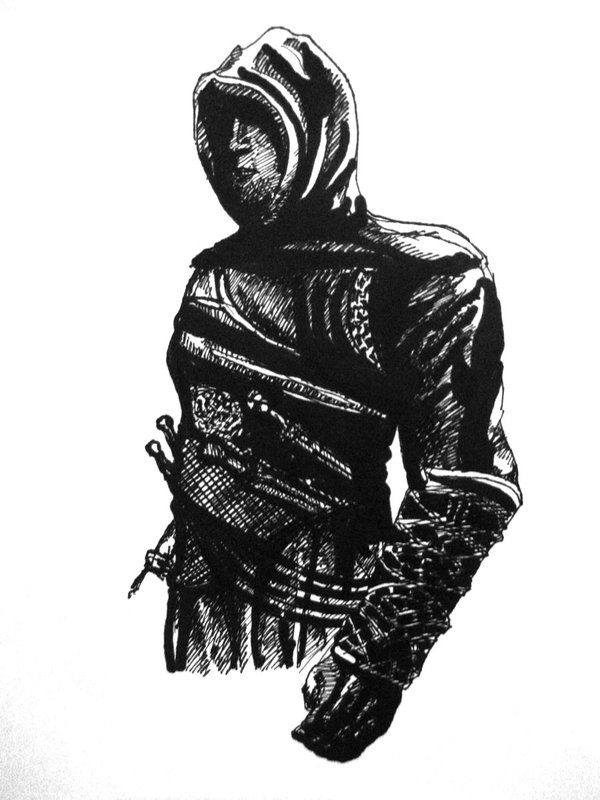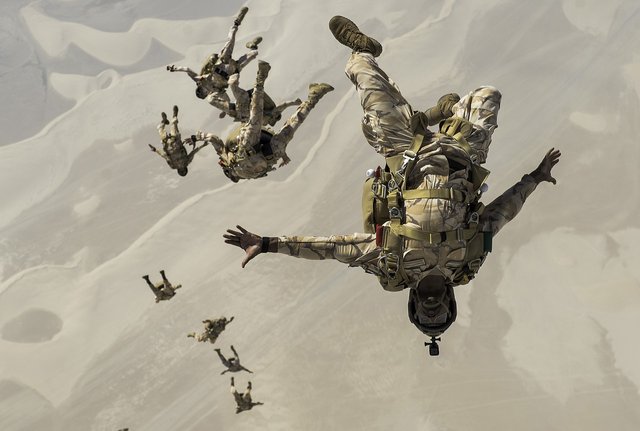The Angel of Mercy. The Assassins. And the Absurdity of Life.
The Angel of Mercy. The Assassins. And the Absurdity of Life.

It’s ironic. If you saw me in person and in civilian clothes, you’d probably think I was someone’s meek, Asian driver or cook. But put a uniform on me, replete with shiny gold “Jump Wings” and a silver “Combat Dive Bubble,” and I’m magically transformed into some mysterious, dark-hearted assassin?
Imagine that?
From the Author
When asked about my military career, I simply tell people that I was “Dumb, Stubborn, and Lucky" - Dumb enough to volunteer, Stubborn enough to stay, and Lucky enough to survive.
This story chronicles a few of the more amusing experiences from over two decades of U.S. military service - the majority of time spent performing operations within the Asian theater. As best as I can remember, the facts and details are submitted unadulterated - with the exception of this one caveat:
Regarding full disclosure, please keep in mind the following conversation.
Curious Man: “What did you learn from your years in the military?”
Me: “The first and last thing they teach you is to forget."
Curious Man: “Who are they and what were you supposed to forget?”
Me: “I don’t know. I forgot.”
Curious Man: “I see. You must have been a good student.”
Me: “I’d like to think so.”
The above conversation gives a clue of why some things will neither be mentioned, nor explained in some of the stories of this series.
Simply put, I forgot. Nevertheless, I am certain you will enjoy.
Namaste,
JaiChai - “Life. Amazing! Isn’t it?"
The Angel of Mercy
Assuming that I’d not heard her the first time, she repeated, “Chief, is there anything else I can do for you?”
She was a 19 year old Fil-Am (Filipina-American) who had recently graduated from Basic U.S. Navy Hospital Corpsman School. She was performing her mandatory clinical phase aboard this Navy Submarine Tender - a ship equipped with hyperbaric chamber facilities, the ship I’d been flown to almost 20 hours ago for hyperbaric treatment.
I had just finished a Table VI treatment in the “Squeeze Chamber” and was on the ship’s tiny medical sickbay cum ward.
The cute Corpsman had assumed correctly. And what a sweet ass-sumption it was!
(But I stray from the story. Fair Warning: Many tangents to follow.)
I hadn’t heard a word of what she said since reporting to her ward. I was too enamored with her brown skin, hypnotic eyes, and oh-so-slim and sexy body. Most other bodily functions were put on hold – except of course, you know what.
Yup. Us men are like that.
Arriving at the Tender yesterday night via emergency MEDEVAC helicopter, I was semi-conscious and clad in only my dive shorts - the Navy issued UDT, khaki-colored shorts worn by all U.S. military divers, Special Warfare, and Explosive Ordnance Disposal Teams. I was swaddled in several black wool blankets to combat the coldness of shock - and as a bonus, kept me securely subdued like the coils of a giant anaconda.
I vaguely remember feeling like the raw fish center of a huge sashimi entree.
The helo crew and medical attendants were more than happy to release me to the Diving Medical Officer of the Tender.
According to the official medical reports, I was so disoriented and obstinate that I tried to free myself from the gurney straps and jump out of the MEDEVAC helo - not once, but three times!
Luckily, the attendants were consummate professionals; and although they couldn’t sedate me - sedation masked symptomatic alterations of consciousness and rendered further neurological checks useless; they nonetheless, “motivated” me to behave.
They did this by menacingly waving a large urethral catheter in front of my face while simultaneously snapping the bases of their surgical gloves. The meaning was instantly understood: “Chief, play nice or we’ll have to shove this rubber tube up your crank; and perform a sphincter muscle control check - both without lubrication!"
Prudently, I acquiesced to these kind and caring medical professionals.
Most divers “free-balled” it. We didn’t wear anything under our dive shorts. It was much more comfortable and practical. At least that’s what we’d rationalized as we pissed and crapped in our shorts during long dives, or scratched sand from our balls while on the beach. Of course, we were more disciplined during cold water dives that required a wet or dry suit to be worn over our dive shorts. This habit of "free-balling it" made it impossible for me to conceal the raging hard-on I was sporting right under the bed sheet.
Efforts to focus on anything else but the female Corpsman proved futile. No matter what kind of mind game I tried, the fantasies kept rolling in. Oh well, I decided to stop worrying about it anymore and go with the flow - so to speak.

The Corpsman saw what was going on and blushed a nice shade of rosy red. But she still went about her business as professionally as possible - temperature, pulse, and blood pressure checks, I.V. drip check, neurological/circulation checks, level of consciousness checks, etc., while still managing to steal glances, and sometimes longer looks, at my rock-solid, uncontrolled erection.
Probably projecting my wishes upon her, I could swear she looked hungry.
Too much of a “Good Thing”
She asked me if I was experiencing “priapism,” a medical condition characterized by an uncontrollable erection and can be caused by trauma to the spinal cord, various drugs, neurological disorders, and vascular diseases.
Prolonged priapism can become a medical emergency because the human penis was not meant to be perpetually engorged. The specialized, sensitive tissues can be permanently damaged or necrose (die). The condition is considered hazardous after three hours, critical after four hours, and a medical emergency after five or six hours - depending on the patient’s age and physical condition.
The treatment for priapism begins with mild, over-the-counter medication (e.g., pseudoephedrine). If that doesn’t work, treatment becomes more aggressive. To make your erection go away, blood is aspirated from the corpus cavernosum - a reservoir for blood and pressure.
Layman’s translation: The doctor sticks a needle in your dick and tries to deflate it by relieving the build-up of pressure.
Sound fun?
Finally to the final of all options, if all else fails, amputation of the penis must be considered - Yikes! That’s why the abuse of erectile dysfunction drugs (e.g., Viagra, Cialis, Levitra, etc.) can literally cost a man his own manhood!
"Unlike the mind, a penis stretched by new stimuli MUST return to its original size. - JaiChai"
I had only experienced priapism once in my life. It happened a few years ago after a rather nasty PLF - Parachute Landing Fall.
...I couldn’t “John Wayne it in" - a Hollywood style, trotting, stand-up landing, because everyone on my stick (Jump Team) were jumping with old Army “Set 10” parachutes. These chutes were big, awkward to steer, and were made for average, American-sized men carrying full Army Infantry gear.
Everyone on my team was Asian or Hispanic and much smaller than the average American soldier. To make matters worse, we weren’t wearing any infantry gear too. That meant we were using parachutes designed for much bigger men and much heavier loads. Even the greenest Jump Master would deem these circumstances as idiotic, dangerously unsafe and would not sign off on it.
Why did we do it anyway?
Simple. We all knew that we weren't paid to think or ask why. We were paid to follow orders and like Nike says, "Just Do It".
My best guess was that some researcher - or bean counter - from the Department of Defense was working on his thesis - or budgetary proposal, painstakingly jumped through all the hoops and kissed the right butts to get government funding and Pentagon approval.
Once secured, the scientist - or DOD money hawk - had carte blanche over the means and personnel needed to carry out his mission. The volunteers meeting the experiment's test subject criteria - human guinea pigs - were given special privileges and compensation
Who cares if the dumb schmucks who volunteer get injured?
The Dumb Schmucks
We were the dumb schmucks who volunteered for two reasons: the two weeks of “basket leave" - paid vacation not deducted from earned leave, and additional HDIP -Hazardous Duty Incentive Pay - upon mission completion. HDIP was a whopping $110 extra per hazardous experiment; or episode of exposure to a dangerous element(s), or per time cycles within extreme environments - thermophillic, cryophillic, hydrophillic, dessicated, hypobaric - undersea, hyperbaric-altitude, and more. In other words, operating in any place or setting well beyond the limits of normal human tolerances.

All the warnings and disclaimers on the Hazardous Duty Sign-Up documents didn't phase us a bit. Most of us had already been through much worse - or so we thought. Besides, what could happen?
We were all well-versed in jumping. We all wore the gaudy, golden “Jump Wings” on our uniforms. The Jump Wings and shiny, silver “Combat Dive Bubble” - worn above the left breast pocket - proclaimed to all that we were loony enough to be free-fall qualified and macho, super-horny enough to be Navy Diver certified.

That was just fine with me. I learned early in life - on the streets of four of the largest cities of the United States - that it’s always the shiny, special things (or people) that become targets first.
To my knowledge, there is only one photo of me in my “work clothes and green/brown make-up” in existence. It - with other documents and computer files - is in the custody of a very trusted friend; safely tucked away in an old wooden desk, in an old Asian village home, in an old and remote Asian Province. And there it will stay until enough time has passed and I don’t need “insurance” anymore.
All smart people have insurance. Those who don't have a secure cache of protective documents put themselves - and their loved ones - in an unsecured situation; openly vulnerable to being thrown under the bus whenever somebody important needs a scapegoat.
'Nuff said about that.
Assassins?

On the rare occasions when time constraints forced me to shop in my uniform, the reactions from other shoppers were the same - admiration, disgust or fear. Whenever I needed an item near a crowd of shoppers and started to walk in their direction, the scene was like the parting of the Red Sea - or maybe the wide berth given to leprosy victims.
It was weird.
If you saw me in person and in civilian clothes, I look like an average Asian man. If we were in any European or Arab country, you could easily assume that I was somebody's meek, Asian driver or cook. But put a uniform on me, replete with those two “itty-bitty” pins, and I’m magically transformed into some mysterious, dark-hearted assassin?
Assassin?
The word assassin always makes me chuckle. It comes from the word “Hassassin” – a medieval group of individuals who conducted guerilla warfare style raids against the invading Crusaders and rumored to use hashish in their rituals.
According to legend, hashish was used in the form of a magic potion. The famous “Marco Polo” accounts of the assassins and their leader tell a story of the “Old Man of the Mountain” believed to be Hasan-i-Sabbah, leader of the Nizari Ismaili militant group.
It is said that he drugged prospective recruits and brought them to a “Paradise” that he’d setup in a secret, secluded compound. Once there, the recruits were provided everything they desired - wine, women, song, etc. Soon afterward, they were drugged again and brought back before the Leader.
Then them Leader promised them a guaranteed trip back to Paradise, but only if they served him - or died in his service. Either way, alive or dead, completed service resulted in a return to paradise for the faithful warrior (or their souls).
Maybe those guys were bigger schmucks than we were?
Assassins were highly trained killers that belonged to a group of small, but deadly armies. They meandered through the lands to defend the populace from the Christian Marauders - the Crusaders.
They soon became known as “Hassassins.” Over time, the word changed into “assassin.”
Enough about assassins. Let's get back to the incident that caused my episode of priapism.
A Bad Day at work

Back to the situation at hand: “Big Army Parachute, Not-So-Big Man.”
I knew it was going to be a bad day when the archaic body harness of the big parachute and opening shock made me feel like I was being split in half - from the crotch up!
After beating on my numbed legs, I immediately checked my canopy and saw the next hint of my bad day. Reflexively, I said out loud, “Imagine that?” (my personal “bleeding down” catch-phrase).
For those of you who haven’t been indoctrinated into the wonderful world of hazardous duty, let me cue you in. Almost all operators have a “bleeding down or releasing pressure,” personal catch-phrase they say to themselves to instantly calm down. These catch-phrases serve a vital purpose. They put you into a mindset that’s conducive to survival, especially when you’re “having a bad day at work.”
Catch-phrases will:
Delete damaging/time-consuming emotions from your current scenario.
Help you mentally step out of a hazardous/time-sensitive situation to facilitate quick, often life-saving decisions objectively - as an observer, not a participant.
The "bleeding-down" phrase will relax you, even make you laugh, as you marvel at the absurdity of life.
Again, I said, “Imagine that?”
Above my head, instead of a heavenly full, round canopy, I saw what resembled a huge, used condom! Either a line-over or static electricity was preventing air from inflating my chute.
I was oscillating wildly. All my attempts to inflate the main chute proved unsuccessful. I spread the main shoulder risers – nothing. I did a pull-up and climbed up on one riser and let go – hoping that the popping, spring action of my bodyweight would let some air enter the canopy.
No joy.
I looked for the usual 4-line release system (a way of controlling/steering a parachute by releasing four lines at the rear of the canopy), but then remembered that this was an old army chute with no such capabilities. I pondered whether I should try and find the possible line-over and start cutting lines (one by one) with my hooked shroud line cutter.
By experience, I could “feel” that I had not regained terminal velocity (about 147 mph)...yet. It was probably because of the minor friction caused by the “Used Rubber” flailing above me. Physicists will tell you that one square yard will decrease your free-fall momentum by up to 20 per cent.
But a quick glance at the onrushing ground (perception of ground color begins around the 10,000 to 12,000 foot ceiling) and verification with my wrist altimeter told me that I really didn’t have much time for playing Sherlock Holmes/Brain Surgeon with any offending shroud lines.
Damn, I hate it when this happens.
There I was, wildly falling through the air. My main parachute had malfunctioned and all my attempts to correct it proved futile. I was losing altitude by the second and now it was time to use the last resort: the reserve parachute.
The reserve chute was considered the last resort for a couple of reasons. First, it was much smaller than the main chute; and secondly, the reserve chute for this particular Army Infantry configuration was worn on the stomach. It was called “the belly pack,” because the rest of the soldier’s gear was worn below the main parachute pack on the soldier’s back. Located at the small of the back and extending down past the buttocks, this additional gear worn under the main chute was called the “butt pack.”
In this way, supposedly, the soldier was somewhat balanced in the weight distribution of his gear. Nevertheless, especially with a deployed butt pack and its accompanied, lanyard connected, extracted gear, the normal, preferred vertical posture was almost impossible to maintain.
I had to jettison the main chute via its harness clips (specialized buckles with a two-step process for separating the shoulder harness straps from the main parachute risers). The real trick was timing. Ideally, both buckles are to be opened simultaneously.
Bad news for me.
I couldn’t open both buckles together because I was wildly oscillating through the air. The parachute canopy above me looked like a bag of worms, while I felt like the main attraction at a public hanging, dangling by one riser. This meant that I could only reach one buckle. The other riser was far above the first, tangled amongst shroud lines and the beginning of the canopy skirt.
The furthest buckle had to be opened first. If I opened the nearest buckle, I would have had to wrestle with a taught riser and a buckle buried under tight material. It would be like trying to get to a coin embedded in a fist full of tight shoelace knots.
Doing a pull-up and climbing past the exposed buckle, I cut away a mass of shroud lines with my hooked shroud line cutter, found the buried buckle, and released. Immediately my body assumed an awkward “hanging by one arm” position. The jolt of repositioning was felt all along the left side of my body. Not much pain (probably due to adrenaline). My left hand, arm, and shoulder felt numb and clumsy. I tried to re-stow my hooked shroud-line cutter, but…but, it was gone! I must have lost my grip on it when the opening shock jolted my body.
“Imagine that?”
Oh well, if I survive this, I guess I’ll have to bribe another Survival Equipment person for another cutter. I wasn’t the best at sanitizing my actions. I lost or forgot gear often. Usually, I would just bribe a lower ranked Marine in the Survival Equipment shop to replace my lost gear because it was much easier than filling out the mountain of paperwork required when reporting missing gear for replacement.
The next step during my emergency procedures required releasing the second (last) buckle. That done, I dramatically accelerated downward. I saw the tangled mess of the main parachute assembly, shroud lines, and canopy material fly away from me like a bird of prey releasing a mouse that was too small to eat.
I put one arm out and rolled to my back, faced the sky and assumed a “reverse free-fall position,” that is, instead of the normal free-fall position - face toward the Earth and spread eagle, I now looked more like a dead cockroach.
Ironically, through all this, I smiled while I rolled.
After my initial parachute training and a few jumps under my belt, I grew to love maneuvering during free-fall. It is intoxicating and called “relative work.” It really feels like you’re swimming through the air. It’s like doing gymnastics in a loud, raging river. For example, if you do a stiff-legged, double leg lift, your body is put into a reverse somersault. If you stick one arm or one leg further away from the body, you rotate in that direction. One birthday I did an ungodly amount of jumps and went to sleep that night exhausted, happy, and dreaming of being Superman.
Supine, I pretended to be a badminton birdie.
And within seconds, my free-fall was controlled.
Reaching to my belly pack (reserve parachute), I found the pull ring, and prepared to pull. In one, symmetrical motion I pulled the ring with one hand and abducted my arm (moved the arm away from my body) while simultaneously mimicking the same motion with the other arm.
It looked like I was doing the top half of a ballet dancer’s pirouette. The reason for this was aerodynamic symmetry. If I didn’t copy the motion of the pulling arm, there was a chance that I may rotate onto my stomach again – not a good thing with a “belly pack” reserve setup.
Experiencing “temporal distortion,” I saw the flaps of the reserve shoot open in s-l-o-w m-o-t-i-o-n. A small drogue chute peeked out of the pack and began to extract the rest of the material. It all seemed surrealistic, like I was sliding face down on a giant synthetic “silk slide in the sky".
My mind flashed to the briefing before this jump. Almost as a premonition, I asked the PR (Parachute Rigger) what were the procedures for a malfunctioned reserve chute.
With an evil grin, he said, “Do a Michael Jackson.”
“A what?” I asked.
“Beat it! Beat it! Beat it!” he snorted.
Imagine that?
Then the wall of moving silk disappeared and all of a sudden shroud lines pulled taught and slapped me in the face.
In spite of being a smaller chute, the combination of my relatively light Asian frame and no additional weight from Infantry Gear made the reserve parachute’s opening shock turn me into the helpless victim of a TV Wrestler. I was getting the infamous “back breaker” maneuver.
Great.
Earlier, the first opening shock of the now defunct main chute made me feel like I was being split in half from the crotch up; and now the God’s were trying to bend me in half backwards - like I was some chemlight stick that needed to be activated!
Oh well, at least my day was getting a little better.
I was now under a full reserve parachute, swaying like an airlifted cargo crate.
Pondering my PLF
The next challenge on my checklist was the task of doing a decent PLF (Parachute Landing Fall). The purpose of the PLF was to distribute the impact of landing across the whole body; therefore, theoretically reducing the chances of injury.
But my experiences over the years showed me that even the most perfect PLF’s can result in sprained ankles, broken legs, shattered clavicles, fractured hips, dislocated shoulders, etc.
The Landing Procedures and textbook PLF is as follows:
Maneuver (steer) into the wind, so the chute falls behind you. This is easily done during training jumps. One only has to orient himself into the opposite direction of the wind as indicated by a windsock (on land) or a boat’s flag (over water). Just think “stab yourself with the windsock or flag” and you’re going into the wind. But during real missions, one had to use other clues (e.g., whitecaps on waves, swaying branches of trees, etc.).
Keep your eyes on the horizon – don’t look down. Looking down makes the jumper incorrectly anticipate ground impact because of the illusion of “ground rush.” It also compromises the vertical posture needed to perform a good PLF.
Raise hands over your head, grasp, and hold onto the parachute risers throughout the PLF. This minimizes injuries to the shoulders, arms, and hands by preventing the chance of “flail” injuries - if you’ve ever stubbed your toe, replace your toe with an arm and you know what I mean.
Point toes downward and slightly bend the knees.
Tuck in the head (chin to chest).
Upon impact, immediately allow the body to roll laterally to whichever side that momentum, wind, and terrain moves your body.
Spread your impact force over the following parts of the body: balls of feet, calf, side of thigh, buttock, side of back, rear shoulder.
When performed correctly, the body should naturally fall and roll; ending up in a sitting position and opposite your parachute.
But instead of vertical, I was laying backward at a 45-degree angle. The reserve chute attached to my stomach and absence of butt pack weight forced me to keep as upright as possible by continually pulling on my risers.
I felt like I was stuck at “half-rep” on a Lat-Pull Down machine in the gym set with a full stack of weight.
Oh well, the horizon was in full view. I’d just have to make do.
Ouch! That’s got’ta hurt!
If you saw the way I landed, you’d probably wince with empathy.
Like fans at an American football game who witness a particularly nasty hit (tackle), you’d probably say that familiar American cliché: “Ouch! That’s got’ta hurt!”
Instead of balls of feet, calves, quads, glutes, lats, delts, and roll; my heels hit first. Then came the vicious ground impact on my coccyx (butt bone). The next assault was to the back of my head - Thank God, my Protech helmet didn’t shatter.
I tried to stand, but only made it to my knees. Everything was a spinning, blur. I wasn’t sure if my chute was in front of me or behind me.
My question was promptly answered. It was in front of me.
How did I know?
It re-inflated and began dragging me, head first, along the dirt, grass, and rocks of the drop zone! Whack! One lens of my goggles breaks. Now one-half of my limited vision looked like a muddy spider web. Afraid of plastic chards going into my eye, I shut both eyes and ripped the goggles off my face.
Whack-whack-whack! The side of my helmet kept bouncing off the uneven ground.
(Another gust of wind.)
I tried to lift my head.
Bad idea.
The wind shifted into second gear and the chute began dragging me faster. Shroud lines that had wrapped themselves around my helmet and neck forced my head down into the rock-strewn earth.
Great, now I’m digging a trench with my face.
Then ...nothing.
The next thing I knew, I was in a hospital bed and pitching a tent under the sheet with a curiously non-sensitive erection. Testing the absence of feeling in that most important appendage, I thumped it hard with a snap of my thumb and forefinger. Damn, I felt nothing.
Embarrassingly, that's when I noticed the attending nurse at the foot of my bed.
(To be continued...)
By JaiChai
About the Author
He is a retired U.S. Military veteran. Believing that school was too boring, he dropped out of High School early; only to earn an A.A., B.S., and MBA in less than 4 years much later in life – while working full-time as a Navy/Marine Corps Medic. In spite of a fear of heights and deep water, he freefall parachuted out of airplanes and performed diving ops in very deep, open ocean water. He spends his days on an island paradise with his teenage daughter, longtime girlfriend and three dogs.
good job
Thank you very much fo your kind words.
Namaste,
JaiChai
Wow!
Looking forward to more.
Thank you for sharing this great conglomeration of stories
Thank you so much.
Glad you enjoyed it.
You'll surely enjoy the next story about all the stupid stuff I volunteered for 'cause I believed was an "invulnerable", bad-ass punk. Not!
Regards to you and yourn.
Namaste,
JaiChai
thanks for sharing keep it up
Thank you, Sir.
I'm grateful for the encouragement.
Next story soon forthcoming.
Namaste,
JaiChai
That was genuinely interesting and fun to read! Amazing experiences, man. I'll follow for more!
Thanks a lot. I appreciate you taking the time to comment with your kind words.
Namaste,
JaiChai